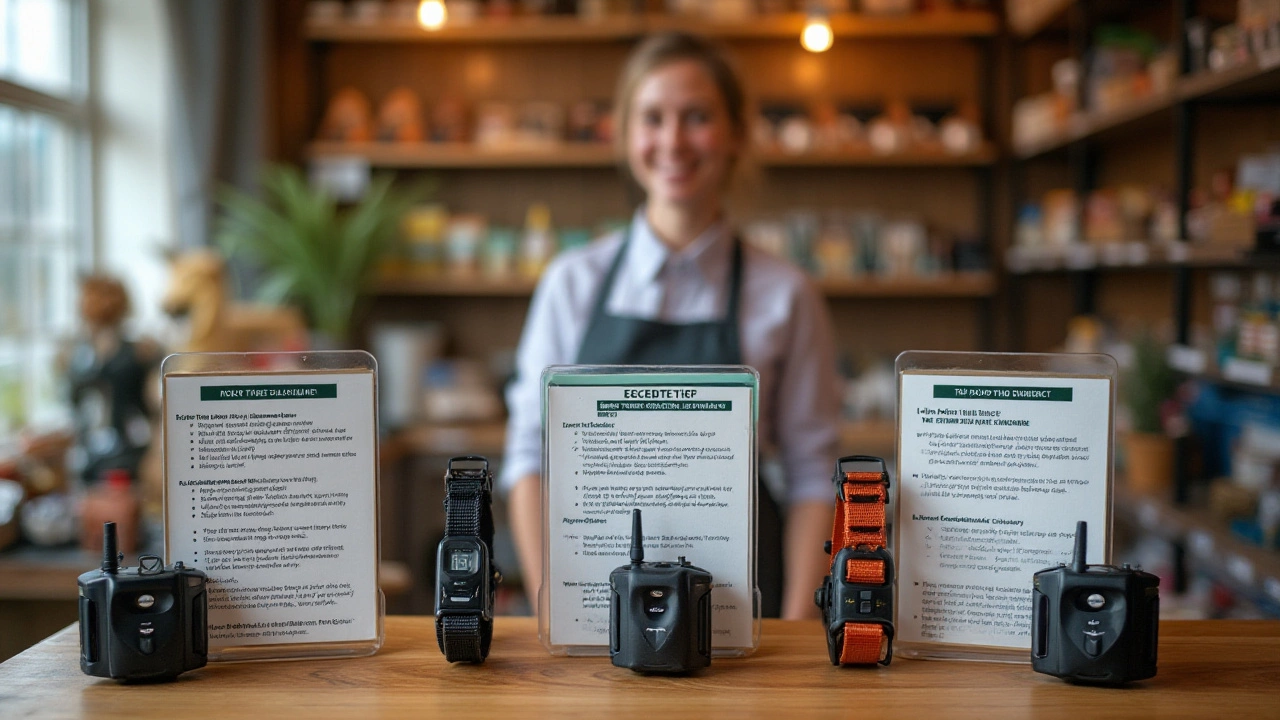Let’s dive into the world of e-collars, a topic that often sparks lively discussions among dog owners and experts alike. These collars, designed to assist with training or behavior management, have stirred mixed opinions. Are they just a tool, or do they impact much more?
This article unravels the nuances surrounding e-collars, with insights from veterinarians on their recommended use. Whether you’re considering an e-collar for your furry companion or simply curious, understanding both sides of the fence can make all the difference. Discover how these tools could work for or against your canine friend, while considering professional guidance for their safe application.
Understanding E-Collars
E-collars, short for electronic collars, have become a point of interest in the world of animal training and behavior management. They are designed to allow for communication between the pet owner and the dog from a distance, relying on signals to prompt or correct certain behaviors. At their core, these devices primarily use pulses that are meant to catch the dog's attention. Some models also send vibrations or sounds. While they may seem modern, their history traces back several decades, having evolved from rudimentary designs used in the 1960s hunting scene.
The purpose of an e-collar for dogs often hinges on the goals an owner is trying to achieve. Commonly, they are employed in scenarios requiring long-distance communication. For instance, during off-leash training or when addressing instances where verbal commands aren't sufficient, these collars come into play. But alongside their functional uses, they ignite debates centered around ethical considerations and potential welfare concerns. One might ask, "Is this training tool truly beneficial, or does it toe the line of discomfort for our pets?"
Looking broadly, their use has seen both advocacy and opposition. Advocates argue that when used correctly, e-collars can reduce unwanted behaviors efficiently. Trainers who have vouched for their utility often stress the importance of timing and proper calibration of these devices. On the flip side, critics point out the risk of misuse. Stress or anxiety in dogs may arise if the collar is improperly used. Animal welfare organizations have voiced concerns, advocating for positive reinforcement techniques instead of aversive methods. According to a notable animal behaviorist, Dr. John Simmons,
"While electronic collars can serve their purpose, it's essential that users are educated to avoid inadvertently causing stress to their animals."
The technology behind these collars has advanced considerably over the years. Modern e-collars are more adjustable, offering various modes and intensity levels. These features aim to cater to different breeds and temperaments. However, the responsibility lies with the owner to ensure the settings are appropriate. Over-stimulation can lead to behavioral issues rather than solutions. Here is where seeking advice from trainers or veterinarians becomes invaluable. They provide insights tailored to the dog's specific needs, ensuring that any corrections made through the collar are aligned with humane treatment.
Despite the availability and versatile functionality of e-collars, a good portion of dog owners opts out for various reasons. Some find alternative training methods more aligned with their philosophy on pet care. Positive reinforcement, for instance, emphasizes rewards over corrections. Viewed as more compassionate, it focuses on fostering a bond between human and dog, rather than command-driven compliance. Even though both methods have their advocates, understanding the nuances of how an e-collar operates offers transparency, aiding owners in making informed decisions.
Moreover, in a survey conducted by Pet Society, it was found that 60% of pet owners were unaware of the actual functionalities and correct use protocols of an e-collar before purchasing one. This highlights the importance of continuous education and dialogue around their use. It is not merely about the technology but understanding and applying it effectively, ensuring the best outcomes for our four-legged friends. Whether weighed through professional endorsement or individual preference, the choice to use an e-collar is indeed significant, with outcomes that ripple across the pet community.

Veterinary Perspectives
When it comes to recommending e-collars for dogs, veterinarians often find themselves in the midst of a complex balancing act between the potential benefits and ethical considerations. E-collars, sometimes referred to as electronic collars, have evolved over the years, and today's versions come equipped with a range of features, from simple tone-based communication to more advanced vibration and static options. Many veterinarians emphasize that these collars can be a helpful tool, especially for training recall and curbing undesirable behaviors, but they are not without their caveats. The use of e-collars varies considerably among professionals, with some viewing them as a valuable add-on for behavior modification, while others caution against their misuse or over-reliance, stressing the need for proper training and humane usage.
Most veterinary professionals agree that one of the major advantages of e-collars is their ability to offer consistent, immediate feedback to a dog, which can be crucial in effectively addressing certain behavioral issues. This immediacy can be especially beneficial for dogs that do not respond well to traditional training methods. However, the ethical debate centers on the nature of the stimuli, particularly concerning the potential distress or anxiety it could induce. The American Veterinary Society of Animal Behavior expresses concern about any form of training equipment that could cause fear or pain, advocating for positive reinforcement techniques as a first line of approach.
The renowned Dog Training Association states, "When used responsibly, e-collars can enhance dog-owner communication, especially over long distances. However, they must never replace the foundational bond of trust and understanding based on reward-based training."Despite the contentious nature of e-collars, many experts agree that success largely depends on the owner's education and willingness to employ them correctly. Misuse, such as improper timing or excessive intensity, can lead to undesirable side effects such as increased anxiety, aggression, or fear-based behaviors—the very traits these collars aim to eliminate.
Interestingly, studies reveal diverse outcomes depending on the methodology used. A recent survey highlighted that approximately 60% of dog owners found e-collars effective when integrated with positive reinforcement strategies, whereas those who used them in isolation reported less satisfactory results. This data underscores the importance of integrating various tools and techniques in a dog’s behavior training regime. Strong collaboration between veterinarians, certified animal behaviorists, and dog owners can ensure the safe and effective use of e-collars, with a pragmatic approach that considers each dog’s unique needs and personality.
The debate around e-collars underscores the broader discussions in the veterinary field about humane animal treatment and effective behavior management methods. While veterinarian advice plays a crucial role, it's equally important for dog owners to stay informed and considerate, viewing e-collars not as a quick fix but part of a more comprehensive training process. In sum, e-collars remain a debated yet legitimate tool in the expansive toolkit of dog training, with the potential for productive application when used thoughtfully and responsibly.

Benefits and Risks
When we examine the world of e-collars for dogs, it's essential to weigh the potential benefits against the risks involved. E-collars are often praised for their ability to provide precise feedback to dogs from a distance, making them a popular choice for off-leash training. They can be invaluable tools in teaching recall, teaching good behaviors, or stopping unwanted actions, such as excessive barking. A well-trained dog using an e-collar may have a better chance of achieving reliable obedience, especially in environments with numerous distractions. These collars are great because they allow for instantaneous communication between the dog and the handler, and many models come with varying levels of control, including sound, vibration, and static correction.
Despite these advantages, the risks associated with e-collars must be considered seriously. Some dogs may experience anxiety or stress due to the collar's sudden corrections, especially if not introduced properly. Additionally, improper use of the e-collar can lead to physical discomfort or even injury, such as skin irritation or worse, burns if the equipment malfunctions or is used incorrectly. One concern shared by veterinarians and dog behaviorists is that without proper training, the use of these tools may promote a fear-based learning approach rather than a positive reinforcement strategy. It's crucial to note that the collar should not substitute for comprehensive training but rather serve as an aid in certain situations.
"The effective use of e-collars requires thorough knowledge and a thoughtful approach," says Dr. Susan Brown, a renowned veterinary behaviorist. "Owners must ensure they are trained in how to use these devices responsibly and with their pet's welfare in mind."
To address both benefits and risks, a pet owner must first ensure the choice of an appropriate e-collar suitable for their dog's size and temperament. Enlisting professional help from a dog trainer familiar with e-collars can greatly assist in mitigating potential dangers. Understanding the distinct behavioral signs of stress or discomfort in dogs is vital, as it can inform timely interventions to prevent harm. Whew, that seems like a lot? It actually gets easier once you're familiar with your pet's responses.
In a world where dog training is continually evolving, research continues to provide insights into the safe application of these tricky tools. Statistically speaking, it's been found that owners who engage in guided training sessions while using e-collars report a higher success rate and fewer negative incidents. This has been supported by various studies and anecdotal evidence within the community of professional dog trainers. There's always one crucial takeaway: the dog's well-being should be at the heart of any training method.

Tips for Safe Use
When it comes to employing e-collars for dogs, safety is the top priority for any responsible dog owner. Understanding the proper way to use these devices can significantly impact the health and happiness of your furry friend. To start, it's crucial to assess your dog's temperament and training needs. Not all dogs respond the same way; some may be more sensitive or have varying anxiety levels. Ensuring your dog is suitable for an e-collar will make a big difference in their experience. Make sure to set the stimulus level to the lowest effective setting; this avoids unnecessary stress or discomfort, making training both productive and humane.
Training sessions should always be kept positive and constructive. It's beneficial to pair the use of an e-collar with positive reinforcements like treats or verbal praise. This ensures that your pet develops a clear association between the desired behavior and a reward. A renowned animal behaviorist, Dr. Sophia Yin, emphasized the crucial balance between traditional training methods and modern tools when she said, "The key to success in training lies in the harmony between understanding your pet's language and the tools you choose to employ."
“The key to success in training lies in the harmony between understanding your pet's language and the tools you use to employ.”—Dr. Sophia Yin
Another important aspect is the duration for which the e-collar is used. Keeping it on for extended periods can lead to physical issues, such as skin irritation. Aim to use the e-collar during specific training sessions only. Dogs also need breaks just like humans, so it’s important to monitor your dog’s behavior to ensure the e-collar doesn't become an irritant. Also, read and follow any manufacturer's instructions. It's always a good idea to consult with a veterinarian or a dog trainer who is experienced with electronic devices before you start using one.
Consider starting with a trial period under supervision to observe how your dog responds to the device and adjust as necessary. This period might involve a lot of close monitoring, but it’s essential for a safe introduction to the collar. Some owners find it helpful to keep a journal of each session, noting successes and areas for improvement. This documentation can provide invaluable information on what works best for your pet and highlight any potential issues early on. Finally, community forums and pet-owner groups can be great resources for tips and shared experiences, but ensure the information comes from reputable sources.
